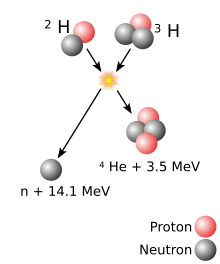Flerovium
The lab's name, in turn, honours Russian physicist Georgy Flyorov (Флёров in Cyrillic, hence the transliteration of "yo" to "e").
Very little is known about flerovium, as it can only be produced one atom at a time, either through direct synthesis or through radioactive decay of even heavier elements, and all known isotopes are short-lived.
[28] The definition by the IUPAC/IUPAP Joint Working Party (JWP) states that a chemical element can only be recognized as discovered if a nucleus of it has not decayed within 10−14 seconds.
[60][61] This island of stability, supposedly from copernicium (Z = 112) to oganesson (Z = 118), would come after a long "sea of instability" from mendelevium (Z = 101) to roentgenium (Z = 111),[60] and the flerovium isotopes in it were speculated in 1966 to have half-lives over 108 years.
No flerovium atoms were detected; this was thought to be because the compound nucleus 288Fl only has 174 neutrons instead of the supposed magic 184, and this would have significant impact on the reaction cross section (yield) and half-lives of nuclei produced.
[66] The first sign of flerovium was found in December 1998 by a team of scientists at Joint Institute for Nuclear Research (JINR), Dubna, Russia, led by Yuri Oganessian, who bombarded a target of plutonium-244 with accelerated nuclei of calcium-48: This reaction had been tried before, without success; for this 1998 attempt, JINR had upgraded all of its equipment to detect and separate the produced atoms better and bombard the target more intensely.
The decay energy measured was 9.71 MeV, giving an expected half-life of 2–23 s.[68] This observation was assigned to 289Fl and was published in January 1999.
This fits well with the systematics and trends of flerovium isotopes, and is consistent with the low beam energy chosen for that experiment, though further confirmation would be desirable via synthesis of 294Lv in a 248Cm(48Ca,2n) reaction, which would alpha decay to 290Fl.
They found the early data inconclusive, but accepted the results of 2004–2007 as flerovium, and the element was officially recognized as having been discovered.
[79][80] To get around this problem with hot fusion, the decay chains from which terminate in spontaneous fission instead of connecting to known nuclei as cold fusion allows, experiments were done in Dubna in 2015 to produce lighter isotopes of flerovium by reaction of 48Ca with 239Pu and 240Pu, particularly 283Fl, 284Fl, and 285Fl; the last had previously been characterized in the 242Pu(48Ca,5n)285Fl reaction at Lawrence Berkeley National Laboratory in 2010.
[90] In accordance with the proposal received from the discoverers, IUPAC officially named flerovium after Flerov Laboratory of Nuclear Reactions, not after Flyorov himself.
[8] Flyorov is known for writing to Joseph Stalin in April 1942 and pointing out the silence in scientific journals in the field of nuclear fission in the United States, Great Britain, and Germany.
[91] In a 2015 interview with Oganessian, the host, in preparation to ask a question, said, "You said you had dreamed to name [an element] after your teacher Georgy Flyorov."
"[92] Very few properties of flerovium or its compounds have been measured; due to its extremely limited and expensive production[22] and the fact that it decays very quickly.
The next closed nucleon shells (magic numbers) are thought to denote the centre of the long-sought island of stability, where half-lives to alpha decay and spontaneous fission lengthen again.
[93] Initially, by analogy with neutron magic number 126, the next proton shell was also expected at element 126, too far beyond the synthesis capabilities of the mid-20th century to get much theoretical attention.
[83] Experiments were done in 2000–2004 at Flerov Laboratory of Nuclear Reactions in Dubna studying the fission properties of the compound nucleus 292Fl by bombarding 244Pu with accelerated 48Ca ions.
[95] It has also been suggested that a neutron-rich flerovium isotope can be formed by quasifission (partial fusion followed by fission) of a massive nucleus.
[98][99] The fission-survived isotope 298Fl, long expected to be doubly magic, is predicted to have alpha decay half-life ~17 days.
[97] One possibility for making the theorized long-lived nuclei of copernicium (291Cn and 293Cn) and flerovium near the middle of the island, is using even heavier targets such as 250Cm, 249Bk, 251Cf, and 254Es, that when fused with 48Ca would yield isotopes such as 291Mc and 291Fl (as decay products of 299Uue, 295Ts, and 295Lv), which may have just enough neutrons to alpha decay to nuclides close enough to the centre of the island to possibly undergo electron capture and move inward to the centre.
[83] Another possibility is to use controlled nuclear explosions to get the high neutron flux needed to make macroscopic amounts of such isotopes.
[83] Some such isotopes (especially 291Cn and 293Cn) may even have been synthesized in nature, but would decay far too quickly (with half-lives of only thousands of years) and be produced in far too small quantities (~10−12 the abundance of lead) to be detectable today outside cosmic rays.
[107] A 2010 study published calculations predicting a hexagonal close-packed crystal structure for flerovium due to spin–orbit coupling effects, and a density of 9.928 g/cm3, though this was noted to be probably slightly too low.
These calculations found that the face-centred cubic and hexagonal close-packed structures should have nearly the same energy, a phenomenon reminiscent of the noble gases.
[3] For example, the dioxide (FlO2) is expected to be highly unstable to decomposition into its constituent elements (and would not be formed by direct reaction of flerovium with oxygen),[3][112] and flerovane (FlH4), which should have Fl–H bond lengths of 1.787 Å[113] and would be the heaviest homologue of methane (the lighter compounds include silane, germane and stannane), is predicted to be more thermodynamically unstable than plumbane, spontaneously decomposing to flerovium(II) hydride (FlH2) and H2.
[118] Adsorption properties of the resultant atoms on a gold surface were compared to those of radon, as it was then expected that copernicium's full-shell electron configuration would lead to noble-gas like behavior.
Two of the three atoms showed adsorption characteristics associated with a volatile, noble-gas-like element, which has been suggested but is not predicted by more recent calculations.
These experiments gave independent confirmation for the discovery of copernicium, flerovium, and livermorium via comparison with published decay data.
Further experiments in 2008 to confirm this important result detected 1 atom of 289Fl, and supported previous data showing flerovium had a noble-gas-like interaction with gold.
[16] In their paper, the scientists refrained from calling flerovium's chemical properties "close to those of noble gases", as had previously been done in the 2008 study.




